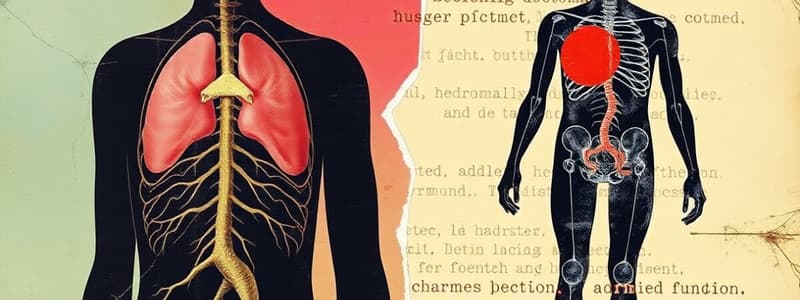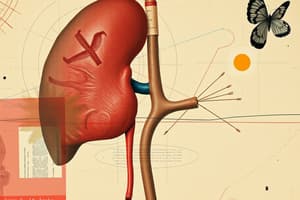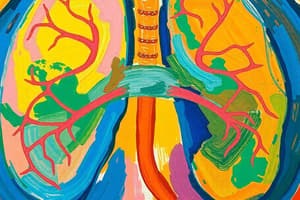Podcast
Questions and Answers
What is the typical result of an ACTH stimulation test in a dog with Addison's Disease?
What is the typical result of an ACTH stimulation test in a dog with Addison's Disease?
- Increased cortisol production
- No significant change in cortisol levels (correct)
- Decreased ACTH levels
- Excess aldosterone secretion
Which type of Cushing's Disease is most commonly associated with a pituitary tumor secreting ACTH?
Which type of Cushing's Disease is most commonly associated with a pituitary tumor secreting ACTH?
- Adrenal Tumor Cushing's Disease
- Iatrogenic Cushing's Disease
- Pituitary Dependent Hyperadrenocorticism (correct)
- Ectopic ACTH Secretion
What clinical sign is NOT typically associated with Hyperadrenocorticism?
What clinical sign is NOT typically associated with Hyperadrenocorticism?
- Abdominal enlargement
- PU/PD
- Anorexia (correct)
- Truncal obesity
In dogs with Addison's Disease, the lack of which hormones is considered life-threatening?
In dogs with Addison's Disease, the lack of which hormones is considered life-threatening?
Which of the following is a common clinical sign of hyperadrenocorticism in dogs?
Which of the following is a common clinical sign of hyperadrenocorticism in dogs?
What is the primary purpose of the ACTH stimulation test in evaluating adrenal function?
What is the primary purpose of the ACTH stimulation test in evaluating adrenal function?
What does a positive Dexamethasone suppression test indicate in dogs with suspected Cushing’s disease?
What does a positive Dexamethasone suppression test indicate in dogs with suspected Cushing’s disease?
Which condition is characterized by insufficient cortisol production and is commonly known as Addison's disease?
Which condition is characterized by insufficient cortisol production and is commonly known as Addison's disease?
Which of the following symptoms is primarily associated with hyperadrenocorticism (Cushing's disease)?
Which of the following symptoms is primarily associated with hyperadrenocorticism (Cushing's disease)?
In the mineralocorticoid regulation pathway, what is the primary role of aldosterone in the kidneys?
In the mineralocorticoid regulation pathway, what is the primary role of aldosterone in the kidneys?
What is the primary purpose of the ACTH Stimulation Test?
What is the primary purpose of the ACTH Stimulation Test?
Which statement accurately describes the results of the Dexamethasone Suppression Test in dogs with Cushing's disease?
Which statement accurately describes the results of the Dexamethasone Suppression Test in dogs with Cushing's disease?
Which condition might present normal results in an ACTH Stimulation Test?
Which condition might present normal results in an ACTH Stimulation Test?
What does an elevated urine cortisol creatinine ratio indicate?
What does an elevated urine cortisol creatinine ratio indicate?
What does specificity measure in screening tests for Hyperadrenocorticism (HAC)?
What does specificity measure in screening tests for Hyperadrenocorticism (HAC)?
What is a critical factor influencing the results of the ACTH Stimulation Test?
What is a critical factor influencing the results of the ACTH Stimulation Test?
Why is the Urine Cortisol Creatinine Ratio not used to diagnose hyperadrenocorticism?
Why is the Urine Cortisol Creatinine Ratio not used to diagnose hyperadrenocorticism?
What outcome is expected in non-iatrogenic Cushing's disease regarding the gland's anatomy?
What outcome is expected in non-iatrogenic Cushing's disease regarding the gland's anatomy?
Flashcards
Addison's Disease (Hypoadrenocorticism)
Addison's Disease (Hypoadrenocorticism)
A condition where the adrenal glands don't produce enough cortisol and aldosterone, leading to various health issues.
Hyperadrenocorticism (Cushing's Disease)
Hyperadrenocorticism (Cushing's Disease)
A condition relating to overproduction of cortisol due to adrenal glands or certain pituitary gland tumors.
Primary Adrenocortical Failure
Primary Adrenocortical Failure
Failure of the adrenal glands to properly respond to signals or generate important hormones like cortisol and aldosterone.
Clinical Signs of Hyperadrenocorticism
Clinical Signs of Hyperadrenocorticism
Signup and view all the flashcards
Life-Threatening Complication of Addison's Disease
Life-Threatening Complication of Addison's Disease
Signup and view all the flashcards
Renin-Angiotensin-Aldosterone System (RAAS)
Renin-Angiotensin-Aldosterone System (RAAS)
Signup and view all the flashcards
Aldosterone's Role
Aldosterone's Role
Signup and view all the flashcards
Hypothalamus-Pituitary-Adrenal (HPA) Axis
Hypothalamus-Pituitary-Adrenal (HPA) Axis
Signup and view all the flashcards
Cortisol's Feedback Loop
Cortisol's Feedback Loop
Signup and view all the flashcards
What happens during stress?
What happens during stress?
Signup and view all the flashcards
Normal Na/K Ratio
Normal Na/K Ratio
Signup and view all the flashcards
Na/K Ratio Limitations
Na/K Ratio Limitations
Signup and view all the flashcards
ACTH Stimulation Test
ACTH Stimulation Test
Signup and view all the flashcards
Interpreting ACTH Test
Interpreting ACTH Test
Signup and view all the flashcards
Dexamethasone Suppression Test
Dexamethasone Suppression Test
Signup and view all the flashcards
Dexamethasone Test Variations
Dexamethasone Test Variations
Signup and view all the flashcards
Urine Cortisol Creatinine Ratio
Urine Cortisol Creatinine Ratio
Signup and view all the flashcards
Interpreting Urine Ratio
Interpreting Urine Ratio
Signup and view all the flashcards
Study Notes
Endocrine Testing
- The endocrine system comprises glands that produce and secrete hormones into the bloodstream
- Glands include the pineal gland, hypothalamus, pituitary, thyroid, thymus, pancreas, adrenal, testes, and ovaries.
- Endocrine system assays measure resting hormones or hormone responses to stimulation/suppression.
Adrenocortical Function Testing
- Adrenal glands comprise a cortex and medulla
- Adrenal cortex secretes mineralocorticoids, glucocorticoids, and sex hormones
- Adrenal medulla secretes catecholamines (epinephrine/norepinephrine) and dopamine.
Mineralocorticoid Regulation (RAAS)
- The juxtaglomerular apparatus secretes renin in response to decreased renal perfusion
- Renin converts angiotensinogen to angiotensin I (AI)
- AI is converted to angiotensin II (AII) by ACE
- AII stimulates aldosterone secretion from the adrenal cortex
- Aldosterone conserves water and sodium, thus increasing ECF volume
- Potassium (K+) excretion increases in response to aldosterone's sodium retention
Glucocorticoid Regulation
- Hypothalamus secretes corticotropin-releasing factor (CRF) under stress
- CRF triggers the anterior pituitary to secrete adrenocorticotropic hormone (ACTH)
- ACTH stimulates the adrenal glands to release cortisol
- Cortisol feeds back to inhibit both CRF and ACTH release, maintaining a balanced system.
Adrenal Diseases
- Hyperadrenocorticism (Cushing's disease): excessive cortisol release.
- Hypoadrenocorticism (Addison's disease): decreased cortisol and often aldosterone production. This can be categorized as Typical Addison's (lack of all hormones) or Atypical.
- Other adrenal diseases include hyperaldosteronism, and pheochromocytoma.
Cushing's Disease (Hyperadrenocorticism)
- This condition is classified based on the location of the abnormality:
- Pituitary Dependent Hyperadrenocorticism (PDH): Pituitary tumor secretes ACTH
- Adrenal Tumor (AT): Adrenal tumor secreting cortisol
- Iatrogenic Cushing's can be caused by exogenous steroid administration.
- Ectopic ACTH secretion is rare, ACTH is secreted outside the pituitary and adrenal cortex
Hyperadrenocorticism Clinical Signs
- Polyuria/polydipsia (PU/PD)
- Polyphagia
- Truncal obesity/abdominal enlargement
- Panting
- Muscle weakness/wasting
Addison's Disease (Hypoadrenocorticism)
- Primary adrenocortical failure: failure of the adrenal glands to respond to ACTH or to produce cortisol and aldosterone
- Atypical Addison's: some mineralocorticoid production
- Life-threatening condition due to mineralocorticoid deficiency (hyponatremia, hyperkalemia, reduced ECF, hypovolemia, hypotension, and reduced cardiac output) and lack of glucocorticoids
- Clinical signs include anorexia, vomiting, lethargy, ADR, and diarrhea
- Signalment: frequently observed in young to middle-aged dogs, and more frequently in females
- Useful for screening; Na/K levels
Adrenocortical Function Tests
- ACTH Stimulation Test
- Dexamethasone Suppression Test (Low-dose LDDST, High-dose HDDST)
- Urine-Cortisol Creatinine Ratio
ACTH Stimulation Test
- Evaluates adrenal gland response to exogenous ACTH
- Degree of response proportional to gland size and development.
- Test of choice for diagnosing hypoadrenocorticism
Dexamethasone Suppression Tests
- Evaluates suppression/lack of following dexamethasone injection.
- Under normal conditions, exogenous steroids suppress CRH and ACTH secretion.
- Cortisol levels are monitored before and after injection (4 hours, 8 hours post-injection).
- Classifies the site of the disease.
- Confirms Cushing's disease and differentiates types.
Urine-Cortisol Creatinine Ratio
- Measures cortisol to creatinine ratio in urine.
- Normally low, elevated in excess glucocorticoid release.
- Only used to rule out Cushing's; not for diagnosis of hyperadrenocorticism
- Any stress can cause increase.
Sensitivity/Specificity of Screening Tests for HAC
- Sensitivity: ability of a test to correctly identify animals with the disease. (true positive rate)
- Specificity: ability of a test to correctly identify animals without the disease.(true negative rate)
- ACTH less sensitive but more specific than LDDS.
- LDDST is more sensitive, but less specific
Case Study: Charlie
- 10-year-old MN Cocker Spaniel
- History: severe PU/PD for 3 months, unremarkable PE
- Diagnostics:
-CBC- normal
-Chem- elevated alk phos
- UA- sp gravity 1.005
- UC- e-coli (no effect on PU/PD)
- ACTH Stimulation Test - resting cortisol 2.7, 1-hour post 14.8.
- Could Charlie still have hyperadrenocorticism?
Case Study: Yeti
- 18-month-old female spayed Irish Terrier
- History: 2-day history of decreased activity, depression, anorexia
- PE: laterally recumbent, lethargic, injected mm, hyperemic tacky CRT >3sec, Temp 95.1F, HR=48, RR=16BPM, BP too low to measure.
- Diagnostics:
- CBC- some abnormalities
- Chem- elevated phosphorous, lowered sodium, elevated potassium, and lowered chloride; BUN and creatinine elevated
ER (Emergency Room) Treatment for Yeti
- Aggressive IVF to address hypovolemic shock
- Dextrose, insulin, and IV calcium gluconate (treat hyperkalemia)
- Myocardial protectant (calcium gluconate) preventing repolarization and thus acting as a cardioprotectant
- IV dexamethasone
- ACTH stim (both pre and post-cortisol < 1ug/dl = Addisonian)
Long-term Treatment for Yeti
- PO Pred (glucocorticoid support)
- Percorten injections (mineralocorticoid support)
Thyroid Testing
- Thyroid hormones regulate metabolic rate, growth, and cell differentiation
- Thyroid glands are controlled by the adrenal cortices.
- Thyrotropin-releasing factor (TRF) triggers thyrotropin or thyroid-stimulating hormone (TSH) release
- TSH enhances thyroid growth and thyroxine release.
- Thyroxine (T3 or T4) feeds back to inhibit TRF and TSH production.
Thyroid Disease
- Hypothyroidism: Primarily dogs, horses, ruminants, and swine; cats. Caused by dietary iodine deficiency. Primary gland disease.
- Hyperthyroidism: Primarily cats. Caused by dietary iodine excess. Primary gland disease.
- Thyroid Assays include measuring Total T4, Free T4, and TSH.
Total T4
- Measurement of total thyroxine (free and bound).
- Increased T4 is diagnostic for hyperthyroidism; small % of cats with hyperthyroidism may have normal T4.
- Useful for hypothyroidism screening; 89-100% sensitivity for hypo.
- If T4 in reference range, it’s likely euthyroid.
Free T4 & TSH
- fT4 is less likely to be affected by illness compared to total T4.
- TSH is useful for hypothyroid diagnostics.
Hypothyroidism
- Idiopathic thyroid gland atrophy or immune-mediated lymphocytic thyroiditis
- Less common: abnormal TSH production or abnormal thyroid gland development
- Signs reflect decreased metabolic rate, including lethargy, inactivity, weight gain, cold intolerance
- Dermatologic changes include symmetrical, non-pruritic hair loss, post-clipping alopecia, dry/dull coat, scaling, and hyperpigmentation, recurrent pyoderma, or otitis externa.
- Diagnosis includes decreased Total T4, Free T4, and elevated TSH levels
Hyperthyroidism
- Increased T4 concentrations, most common in cats, caused by thyroid adenoma.
- Clinical signs: weight loss, poor hair coat, aggression, increased appetite, polyuria, polydipsia, increased activity and restlessness, and occasionally panting, difficulty breathing, weakness, or depression.
- Secondary hypertension and cardiomyopathy of concern.
Studying That Suits You
Use AI to generate personalized quizzes and flashcards to suit your learning preferences.
Related Documents
Description
This quiz covers the essentials of the endocrine system, including the various glands and their hormone products. It also delves into adrenocortical functions, mineralocorticoid regulation, and the mechanisms of hormonal responses. Test your understanding of these critical concepts in endocrinology.



